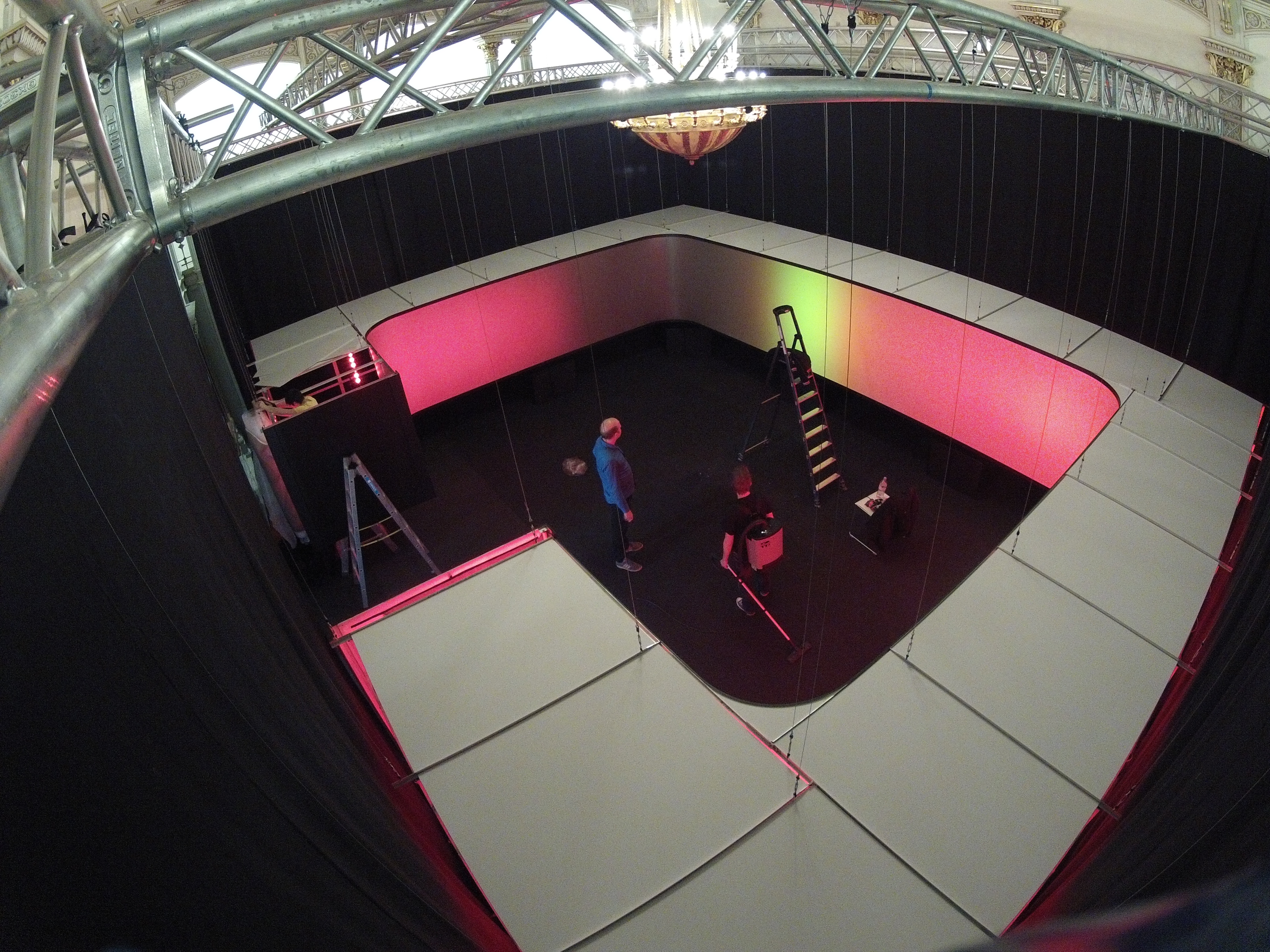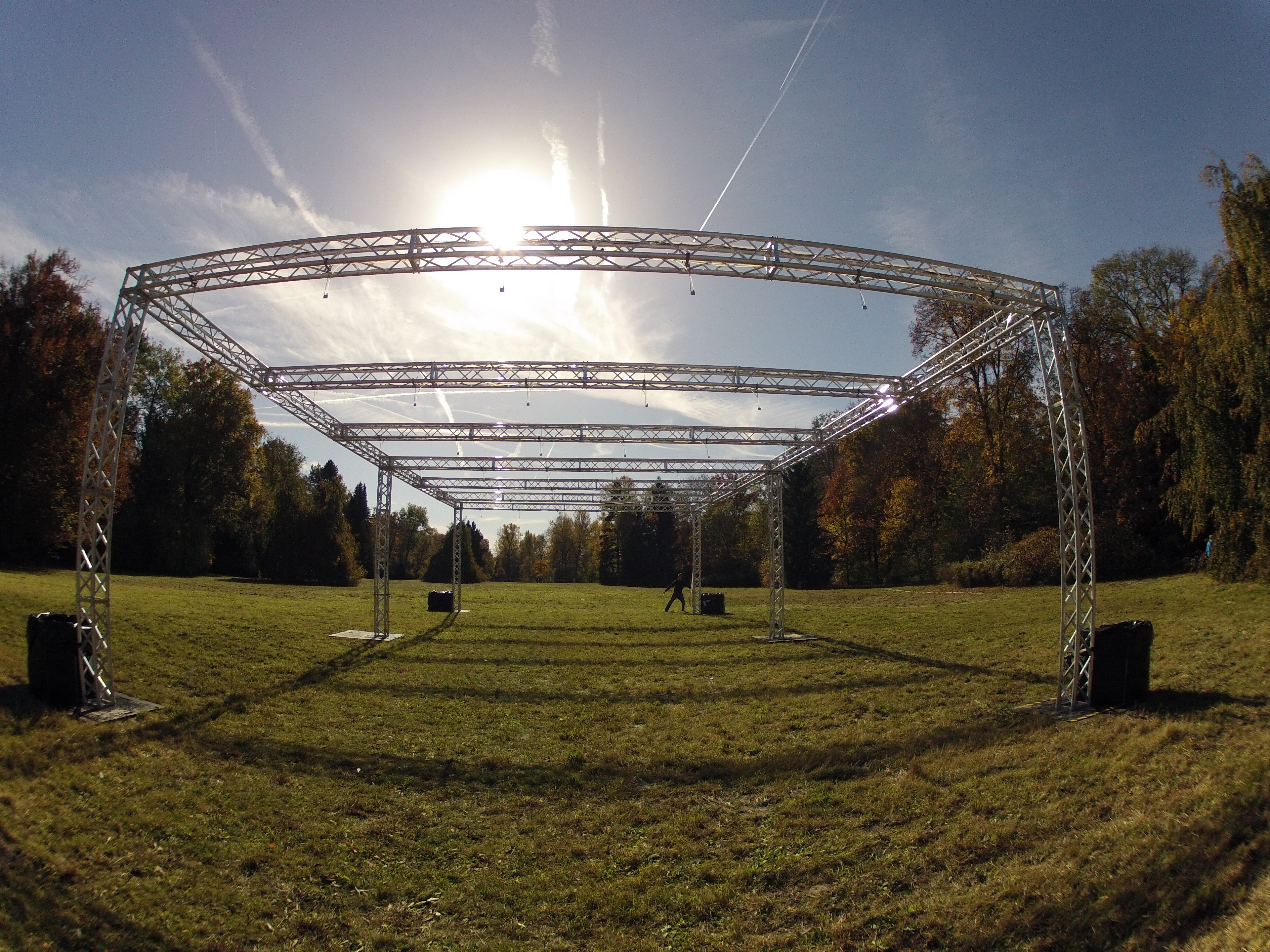Donaueschingen – Musiktage

A couple of days ago we travelled to Donaueschingen, in the south of Germany, near Switzerland. The place, where is difficult to speak English, is said to be the exact point where the Danube has its origin, although looking at the place this seems like a not very truthful statement.
The reason of the visit was to join the team of artist Edwin van der Heide (1), and work on the installation of one of two pieces exhibited by him as part of the contemporary music festival “Musiktage”, held in that city since 1921 (2). This festival is considered as a connoisseurs encounter for the musical art expression, showing new, contemporary and experimental music/sound creations. And although the festival takes place on a small town, with a relative reduced audience, this fact highlights the target the event is directed to.
After the first working days of setting up Edwin’s installation, we had the time to watch one of the concerts within the festival. This (Helmut Oehrings “schienen wie Wellen die in lange Auge -2011-“) was a piece that showed part of the attitude carried by the festival. The sounds you could hear ranged from muted deaf-like guttural gestures, Arabic type guitars, to classical orchestra chords, passing through female soft and soothing vocals, strong choir expressions and metallic-hard percussive sounds which gave a severe strength to the performance at times. Held in Germany, one could get beer, pretzels and sausages with mustard outside in the time in between sections of the concert.
…
The installation we worked on, called DSLE 3, is a synthetic (controlled) space directed towards the visual and sonic experience of audience in space (More information about this can be found on evdh.net). The installation is completed on a square room of around 64 square meters, inside the Biedermann museum. It is basically one single 1.6 meters tall screen going around the room, lit by LEDs from the back. The LEDs’ intensity and colour, as well as the sound accompanying are controlled with great precision achieving the sense of spatiality.


Following, the truss structure where the screen is hung from, floor and mechanical parts forming the installation are all hidden from view with black curtains, carpets and robes, so that the final result is total darkness, from which spectators can only see a wide band of light at eye level (the screen) that surrounds them. An eight channel speakers system is arranged below the screen, distributed symmetrically completing the audio component of the stimulus.
Finally, the experience that is produced is that of an immersive environment in which the audience submerges to be addressed through light, sound, and their movement in space, accomplished by varying parameters that relates visual and sonic stimuli, corresponding not only to frequency and colour, but to speed and rotation of sound and light sources in space as well.
The composition of the piece presents clear and defined colours and sounds, which can induce a kind of trance in the engaged audience. The iteration of the accomplishment of the installation, serving as a tool to create, and refine ideas about stimulus, the installation itself and the content, make this provocation to be so straight forward that it seems to convey a transparent message, that cannot be expressed but with the language of the senses. It is difficult to document the experience, so I find support on some images and a short time lapse.

Video – Time Lapse – Installation Set up
…
Pneumatic
The second piece we engaged with was Pneumatic Sound Field, also by EvdH. Of simpler installation, this work was composed of the same type of metal structure that supported 42 pneumatic valves up around 4 meters above the ground, distributed on a rectangular area.
Starting from the principle that sound is a change in air pressure, these valves open and close on a high resolution manner, liberating the pressurized air, flowing through the distribution hoses. The valves only possess two states: open and closed.

The sound that is accomplished this time is of higher density, and the exploration of it and the questioning of its source is a central figure that can be appreciated by standing below the metal structure, walking around the place, moving away from it and playing with the acoustics of the location. The fact that the sound source is so small (for the high loudness produced) and uncommon to our previous speaker-related experience with sounds, seriously works on the perception of sound.

For this particular case, the location was of great influence, to my taste, on how the sound is perceived. The outdoors installation was set on the side of the Biedermann museum, on a large open field, surrounded by trees and their autumn colours. The installation also faced the mansion in which the owner of all those lands lives, with only the Danube separating the sound structure and the castle. This was such a moving setting for an art piece, with nothing but fortunate good weather and sun bathing the audience, which grew numerous by Saturday and Sunday.
Again, it is hard to truly register the sound, its presence in space, and the overall experience of an experiment like this, take my enthusiast words as part of the documentation only. Pictures are used as aid; however, they will not suffice.
…
We only got to see another piece, “Mostly Brittish”, free improvisation, which consisted of two laptops creating sounds with all types of synthesis and envelopes, generating a diversity of frequencies that cannot be easily described or digested unless you find yourself interested on the basic components of sonic items. Interesting though it was, hard to engage with nevertheless.
Towards the end of the 10 days we spent in Donaueschingen, what is to be appreciated as well is the opportunity of meeting people. People like Pierre Le Lay, who was leading the set-up of DSLE 4, a great Frenchman who earned our respect and appreciation at the same time, with whom we could talk about not only work, but the art behind croissants. Meeting people in the art business, and witness the infrastructure mechanisms and reality of the creative work happening, creative people succeeding at achieving liberation and freedom to develop ideas. Witness (and part of) of the art environment on a larger scale, its flora and fauna, intercommunicating.

1. Heide, Edwin van der. Edwin van der Heide. [Online] 2012. http://evdh.net.
2. Musiktage. Musiktage Festival. [Online] 2012. www.donau.com.
Great work; great experiences. Niiice.